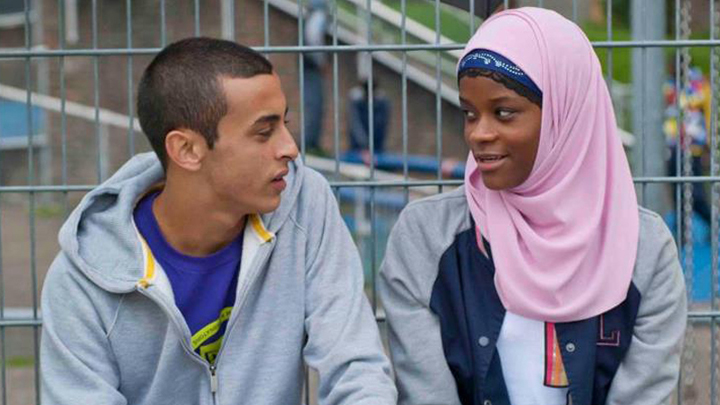My brother the devil is a 2012 British film written and
directed by Sally El Hosaini. It is set in Hackney, London and is a social
realism urban story. The film includes
the themes of Anger, destruction and survival. Anger and destruction are
portrayed throughout because the film features in two brothers and their gang
and the rival gang. Survival is a key part in this film because the film is about
two brothers growing up in gangland London.
Before the film starts we see a series of various photos of
groups of teenagers in different locations. This is the starting point that
gives us a general insight into the sort of setting that will be used and
almost what some of the film will entail. In between these images it shows a
boy who we later find out is called Rashid or Rash (James Floyd) boxing. As the film progresses it may seem that he is
boxing to defend himself against others in his neighbourhood. Another boy who
appears younger; Mohammed or Mo (Fady Elsayed); is show leaving school as close
ups of shirts being signed are shown. Both these small clips at the very beginning
set the scene and characters. Although we are unsure who these people are we
can presume they are going to be the protagonists. After this the images are
shown again and one by is pictured with what look like drugs which give us an
insight to what these boys lives may be like.
When Rashid boxing is shown again it is in slow motion which
may be portraying his focus. Other slow motion shots are used throughout the
film to maybe show the tension. The slow motion shots make me quite curious
because you try and imagine what that person is thinking and how they are
feeling.
The handheld camera is used to show their lifestyles and
status in society. When Mo is terrorised by his brothers rival gang constant
close ups are shown of the boys in the gang. As these close ups are shown the
camera is moving around which puts the audience in Mo’s position as if we are being
pushed around and that is the view we can see. Also as he runs from the gang to
camera is following behind him still using handheld camera to emphasise his instability.
Both gangs meet up at some point in the movie. Demon the
leader of the rival gang has a dog and constant close ups of the dog are shown
to portray to danger of the situation. In this scene Demon lets his dog of his
leash to attack someone. During this time a lot of noise it being made,
shouting, cussing and sounds of the fight occurring. However the boy that the
dog attacks stabs him which causes everything to become silent. This is
effective because it shows the shock of everyone in the area. It is also continuously
silent as Demon (Leemore Marrett Jr.) stabs Rash’s best friend and fellow gang
member Izzi (Anthony Welsh). The silence when Izzi was killed was a surprise
because I thought there would be more of a reaction from Rash’s gang. Instead
both gang’s ran off which made it seem like although the gangs fight no killing
it ever involved.
I liked the shots used when Rash was running away from the
scene because included in this was the sound of his heavy breathing which
portrayed his terror and the unpredictability of what just happened. The sound of the police sirens where also in
the background and when Rash was underneath a bridge you could hear the sound
of a train going past above. The train got louder as it passed and then
everything went silent which makes me think that Rash zoned out and wasn't really
thinking of anything he was just stood there in a daze.
The only light in the house when Rash returned home was
candle beside his mum as she slept and when he attempted to turn on the lights
no lights turned on which emphasises there living situation and lifestyle
because it shows they are poor as they can’t pay for the electricity.
The best shot for me throughout the movie is when Rash gets
a gun and is standing in the bathroom loading it and practicing because he
wants to take revenge. When he holds it up towards the mirror it is dark and he
looks as if he is dressed if pyjamas but the camera suddenly switches round to
the other side of the wall which is also Rash holding a gun up to the mirror
but he is fully clothed and it is daylight. This is used to quickly switch
between the time which it is set; the night before and the morning. His clothes
are then the same when he arrives at the tattoo parlour which highlights what
the mirror shot was about.

In one scene Mo is sitting with his two friends Aisha (Letitia
Wright) and Jamie (Aaron Ishmael). Aisha is listening to music through her
headphones but if is quiet and slightly muffled; they are letting us hear what
Mo can hear in this scene. But when Mo puts o the headphones instead we can
hear the song clearly and louder again giving us things from his perspective. It seems like they what us to relate with Mo because
we keep seeing things from his point of view. Aisha is holding a sparkler and different
views of the sparkler are shown but when the sparkler goes out the music stops
as well and everything is silent.
I enjoyed this film because I think this film showed all the
different struggles that people go through, in this film it ranges from life in
a gang to homophobia. It focused on the two brothers and what they did to find
their true identities
